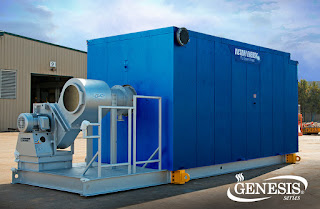 |
Every boiler and steam system has a unique
set of efficiency challenges |
There are numerous, actually about a half million, articles on the web about boiler efficiency. Because of the scale of even modest sized boilers, small increases in production efficiency can translate into very substantial monetary savings. Even when you have squeezed that final increment of efficiency from your boiler, a closer look will likely show there is something more you can do.
Increasing boiler and steam system efficiency is not a "one and done" proposition.
Boosting efficiency will undoubtedly involve controlling elements that were not controlled before, or at least controlling them in a more rigorous manner. This means additional instrumentation and controls that were not part of the system previously. Keeping those measurement and control elements in top working order is key to maintaining operating efficiency at stellar levels. The takeaway point here is that...
Higher efficiency operation is likely accompanied by increased system complexity.
Higher efficiency results from operating within a narrower set of conditions. Excess air, combustion temperature, flue gas composition, and more must be continuously monitored and maintained within the necessary envelope to keep the goal efficiency level throughout the varying demand levels on the system. With proper implementation, this additional complexity should not be an undue burden on the system operators. Automation and functionality built into modern measurement and control elements are capable of handling the normal operation and providing notice when conditions adversely vary from predicted or required ranges.
Increased maintenance activity is an integral part of reaping efficiency savings.
Steam systems, whether for heating a commercial building or driving an industrial process, generally involve extensive piping. The consumptive devices serviced by the system, most often where steam becomes condensate, are also part of the efficiency plan. Their productive use of the process steam contributes to overall savings. If an equipment unit, through the efforts of good maintenance and control, can perform its task with 95% of it previous consumption, that is a positive return on the effort and cost expended to boost performance.
Attaining elevated efficiency can result from added equipment, but maintaining high efficiency is a function of attitude and commitment.
It is important that the managers, supervisors, technicians and contractors responsible for the day to day operation of the system consider efficient operation as a valuable and useful goal. Diligence, discipline, and attention to detail are solid elements of a successful maintenance program.
The US Department of Energy summarizes combustion efficiency on their website.
http://energy.gov/sites/prod/files/2014/05/f16/steam4_boiler_efficiency.pdf
Combustion Efficiency
Operating your boiler with an optimum amount of excess air
will minimize heat
loss up the stack and improve combustion efficiency.
Combustion efficiency
is a measure of how effectively the heat content of a fuel
is transferred into
usable heat. The stack temperature and flue gas oxygen (or
carbon dioxide)
concentrations are primary indicators of combustion
efficiency.
Given complete mixing, a precise or stoichiometric amount of
air is required
to completely react with a given quantity of fuel. In
practice, combustion
conditions are never ideal, and additional or “excess” air
must be supplied to
completely burn the fuel.
The correct amount of excess air is determined from
analyzing flue gas oxygen
or carbon dioxide concentrations. Inadequate excess air
results in unburned
combustibles (fuel, soot, smoke, and carbon monoxide), while
too much results
in heat lost due to the increased flue gas flow—thus
lowering the overall boiler
fuel-to-steam efficiency. The table relates stack readings
to boiler performance.
Combustion Efficiency For Natural Gas
Here are some items that can impact boiler efficiency and steam system operating costs. While the list may point you toward some areas that need attention in your system, a good strategy is to consult a
combustion specialist and share your concerns and goals for system operation. Their expertise will be an integral part of your good decision making.
- Minimize losses due to leaks throughout the entire connected system.
- Rigorously follow boiler and component manufacturer maintenance schedule recommendations.
- Establish means to provide boiler blow-down when excess accumulation of dissolved solids occurs. Conductivity monitoring can be an effective indicator of dissolved solids.
- Insulate all steam and condensate piping and traps.
- Establish steam system operation at the lowest effective pressure. Special condensate return accommodations may enhance ability to operate at lower pressure.
- Perform timely maintenance of steam traps in accordance with best practices.
- Use energy recovery units to heat makeup water with waste heat from flue gas.
- Add variable speed drive controls to boiler feed pumps for lower energy consumption and finer control of feed flow.
- Monitor flue gas O2 and temperature levels to determine combustion efficiency and optimize air-fuel ratio.
- Monitor and control air flow and fuel flow using mass flow measuring and control devices for best accuracy.
- On systems with multiple boilers, incorporate load sensing controls that will sequence and optimize the operation of the units in response to demand.
Certainly there is more detail involved in each item listed, plus numerous other potentially energy saving activities. By continuing to properly maintain your existing system and stay informed about new equipment and technology with promising application, you will keep your steam system operating at the top end of its efficiency range.






























